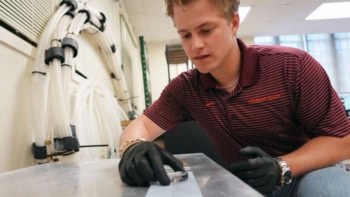What happens if you let a drop of water fall gently onto a water-repelling surface? Physicists in France and the Netherlands who tried the experiment were surprised by what they saw. They found that a violent, ultra-fine jet of water emerges from the drop, moving at up to 40 times the drop's initial impact speed. The researchers believe the unusual behaviour is caused by the collapse of an air cavity that is created when the drop deforms as it hits the surface. The finding could have a bearing on industrial applications in which liquids are coated on to surfaces, such as insecticides being sprayed onto crops or in ink-jet printing (Phys. Rev. Lett. 96 124501).

The experiment was carried out by Denis Bartolo of the Ecole Normale Supérieure (ENS) in Paris and colleagues, who used a high-speed video camera to film what happens when water drops with a diameter of 1 mm fall onto a hydrophobic surface. Although the initial velocity of a drop was only about 0.5 metres per second, the researchers found that an ultrafine, high-speed jet emerged from the drop with a speed that was around 20 metres per second or higher (figure 1).
According to the team, the jets are created by the collapse of air bubbles inside the water droplets as they hit the surface (figure 2). The phenomenon does not occur for water droplets with a higher initial impact velocity (greater than around 0.7 metres per second) because air bubbles are not trapped in the liquid anymore. The team also found that very large air bubbles can remain trapped on the drops in certain circumstances.
“Our results will be important to fully understand drop impact, which is crucial for virtually all coating applications such as spray painting, ink-jet printing and pesticide deposition on plant leaves,” Bartolo told PhysicsWeb. “Both bubble trapping and jet formation would be harmful for these applications: the jets would limit the resolution on printing and bubbles could favour paint peeling.”




